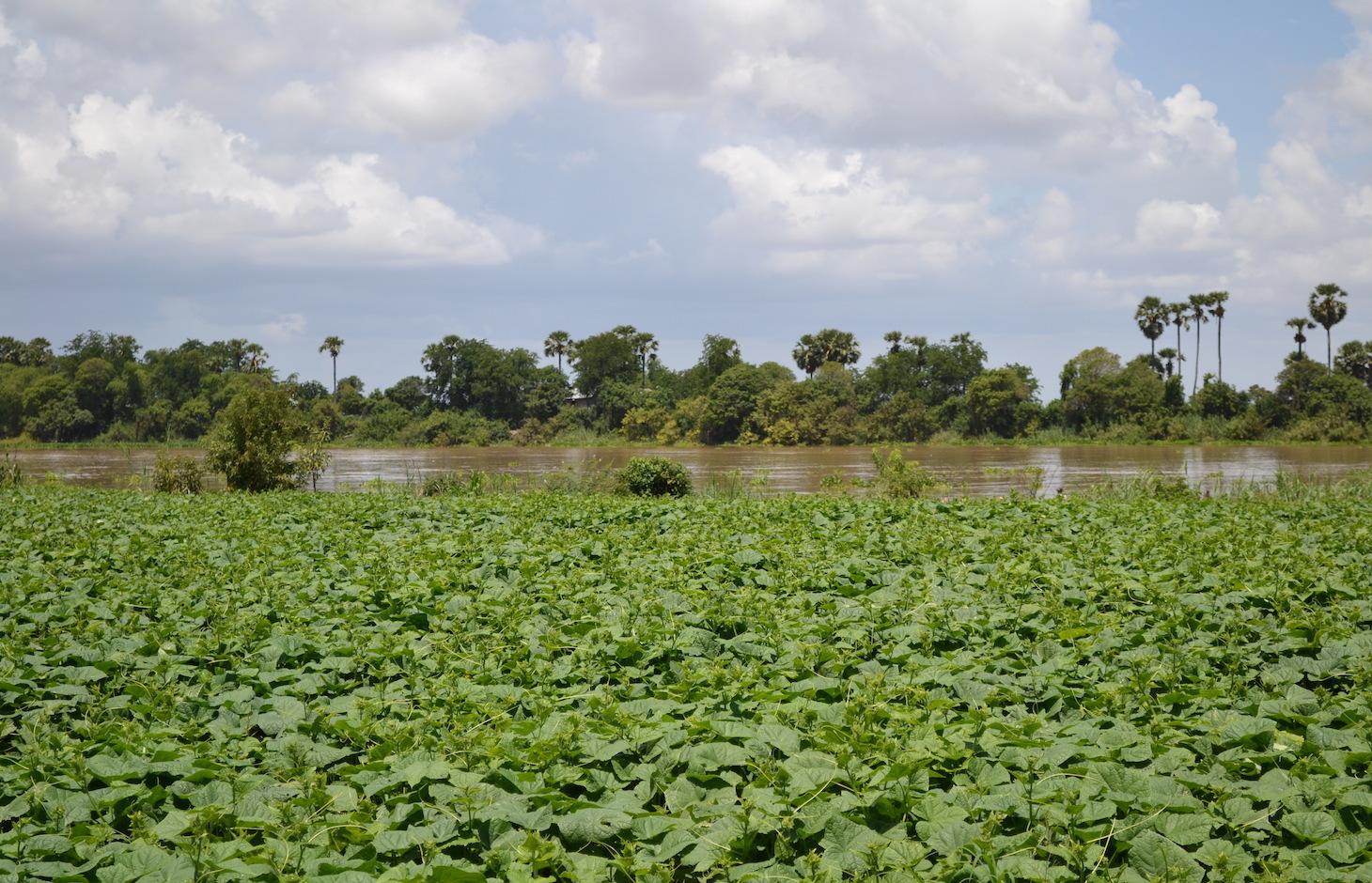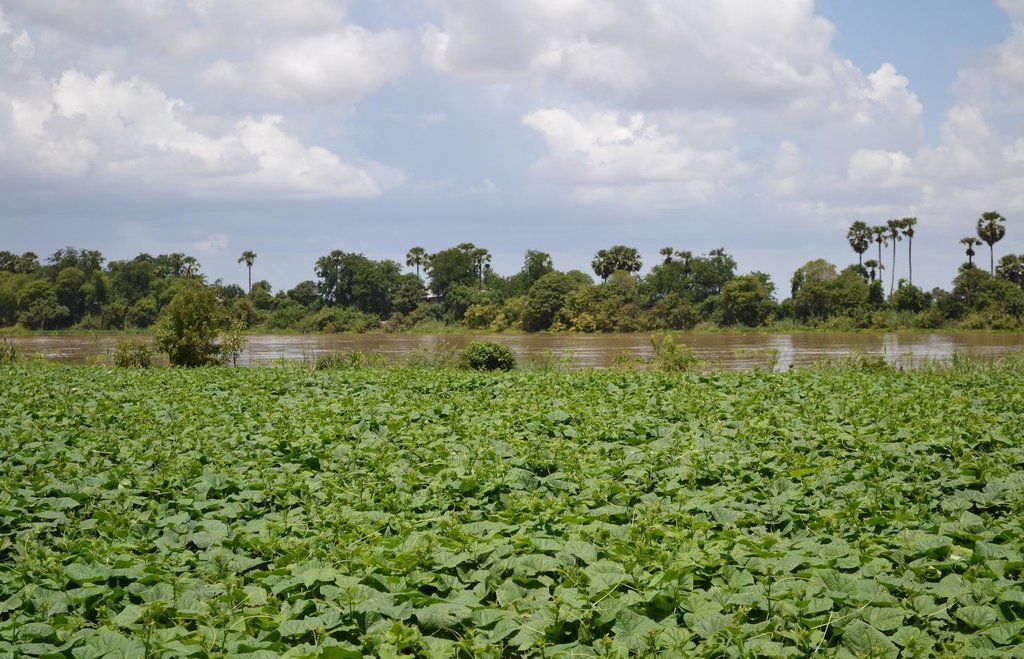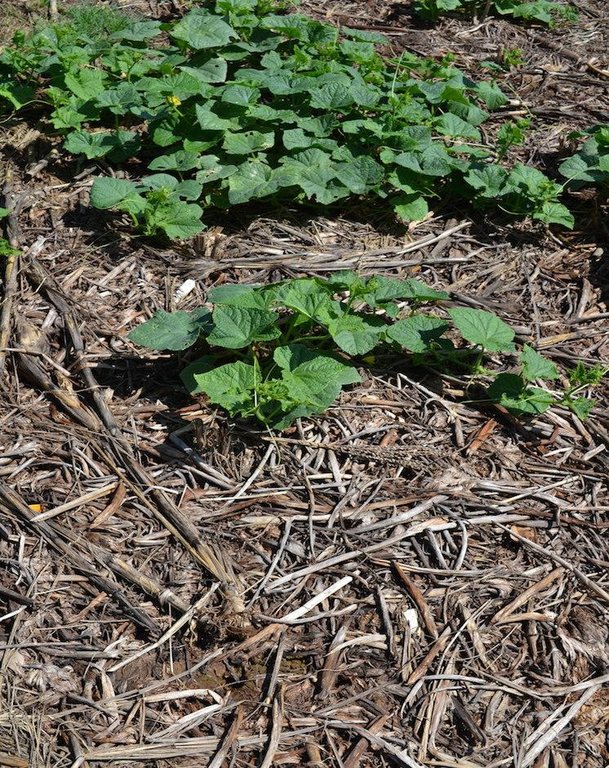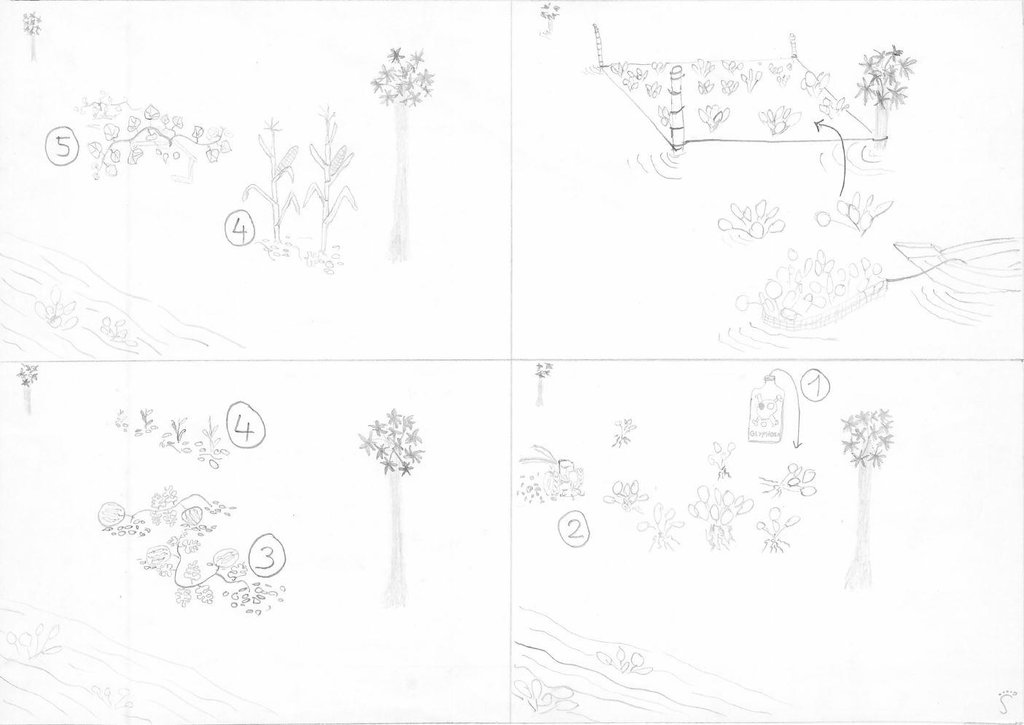Mulching with water hyacinth (Eichhornia crassipes) after the monsoon floods. [Cambodge]
- Création :
- Mise à jour :
- Compilateur : Christoph Kaufmann
- Rédacteur : –
- Examinateurs : Deborah Niggli, Alexandra Gavilano
ការប្រើប្រាស់កំប្លោកជាគម្របដីដំាដំណំាក្រោយពេលទឹកសម្រក (Khmer)
technologies_1223 - Cambodge
Voir les sections
Développer tout Réduire tout1. Informations générales
1.2 Coordonnées des personnes-ressources et des institutions impliquées dans l'évaluation et la documentation de la Technologie
Spécialiste GDT:
Khun Lean Hak
Cambodge
1.3 Conditions relatives à l'utilisation par WOCAT des données documentées
Le compilateur et la(les) personne(s) ressource(s) acceptent les conditions relatives à l'utilisation par WOCAT des données documentées:
Oui
1.4 Déclaration sur la durabilité de la Technologie décrite
Est-ce que la Technologie décrite ici pose problème par rapport à la dégradation des terres, de telle sorte qu'elle ne peut pas être déclarée comme étant une technologie de gestion durable des terres?
Non
1.5 Référence au(x) Questionnaires sur les Approches de GDT (documentées au moyen de WOCAT)
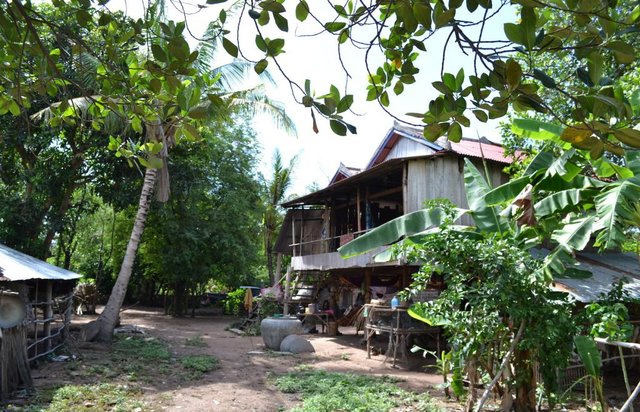
Model farmer [Cambodge]
Model farms were introduced by a NGO in order to spread knowledge about SLM (compost, System of Rice Intensification SRI, and other technologies) in the project area.
- Compilateur : Christoph Kaufmann
2. Description de la Technologie de GDT
2.1 Courte description de la Technologie
Définition de la Technologie:
Water hyacinth (Eichhornia crassipes) is collected during the monsoon floods, attached to poles on the flooded fields, chopped when the water recedes and used as mulch to plant different crops.
2.2 Description détaillée de la Technologie
Description:
This mulching technique is used at the riverside of the Tonle Sap River. The area is flooded during the late rainy season (September to November), and alluvial mud is deposed on the fields, which enhances the soil fertility. The deposition of sediments depends on the extent of the yearly flood, and is threatened by the construction of hydropower dams on the upper Mekong River (Thomas et al. 2012:49), as well as climate change (floods tend to be smaller or more extreme). During the dry season (approximately from January to June, depending on precipitation patterns) the land dries and due to high temperatures and very low precipitations, crops can be harmed.
At first, the farmer gathers the water hyacinth with his boat during the wet season. He surrounds them with a net and pulls them to his fields, where he prepares fences with bamboo poles and iron wires. He fills the fenced area with the water hyacinth. Once the water recedes, he sprays glyphosate on the water hyacinths and chops them by using a hand tractor. He plants his first crop, watermelon, as soon as the soil is dry enough (start of dry season). The crop residues of the watermelon are left on the fields, and he can plant a crop of corn and a crop of cucumber before the next flood enters.
The analyzed area is flat (slope < 2%), tropic (dry and wet season), and the soils are mostly loamy. The groundwater table is rather high with 1-2 m during the dry season (November to May). The area is flooded during and after the wet season (August-September to November). The floods bring sludge and thus nutrients to the fields.
Due to climate change, the rainfalls are more erratic, temperatures rise and droughts are more recurrent. Chili is the cash crop predominantly grown in the flooded area, with floating rice as second crop.
Agricultural activity in this region is confronted with high migration rates (garment industry, cities, or other countries). This is detrimental for the farmers, since there is less labour force available. Also, the presented technology requires a rather high initial investment (especially when a tractor is bought) and an increase of physically strenuous labour. Therefore, the interviewed land user stated that most farmers are reluctant to do high investments on their farm. This is aggravated due to the fact that taking up credits might increase the dependency of the farmer.
2.3 Photos de la Technologie
2.5 Pays/ région/ lieux où la Technologie a été appliquée et qui sont couverts par cette évaluation
Pays:
Cambodge
Région/ Etat/ Province:
Kampong Chhnang
Autres spécifications du lieu:
Kampong Os
Spécifiez la diffusion de la Technologie:
- répartie uniformément sur une zone
Si la Technologie est uniformément répartie sur une zone, précisez la superficie couverte (en km2):
0,02
S'il n'existe pas d'informations exactes sur la superficie, indiquez les limites approximatives de la zone couverte:
- < 0,1 km2 (10 ha)
Commentaires:
Total area covered by the SLM Technology is 0.02 km2.
2.6 Date de mise en œuvre de la Technologie
Si l'année précise est inconnue, indiquez la date approximative: :
- il y a moins de 10 ans (récemment)
2.7 Introduction de la Technologie
Spécifiez comment la Technologie a été introduite: :
- par le biais de projets/ d'interventions extérieures
Commentaires (type de projet, etc.) :
2010 through SOFDEC
3. Classification de la Technologie de GDT
3.1 Principal(aux) objectif(s) de la Technologie
- améliorer la production
- réduire, prévenir, restaurer les terres dégradées
3.2 Type(s) actuel(s) d'utilisation des terres, là où la Technologie est appliquée

Terres cultivées
- Cultures annuelles
Cultures annuelles - Précisez les cultures:
- céréales - maïs
- légumes - melon, citrouille, courge ou cucurbitacées
- cucumber
Nombre de période de croissance par an: :
- 1
Précisez:
Longest growing period in days: 225, Longest growing period from month to month: Mid-December to end of July
Est-ce que la rotation des cultures est appliquée?
Oui
Si oui, veuillez préciser:
He plants his first crop, watermelon, as soon as the soil is dry enough (start of dry season). The crop residues of the watermelon are left on the fields, and he can plant a crop of corn and a crop of cucumber before the next flood enters.
Commentaires:
Major land use problems (compiler’s opinion): Regular flooding, use of pesticides, low soil organic matter, monocultures.
Major land use problems (land users’ perception): Pumping machines and tubes to irrigate are not easily available. High irrigation need as the soil organic matter content is low.
3.4 Approvisionnement en eau
Approvisionnement en eau des terres sur lesquelles est appliquée la Technologie:
- mixte: pluvial-irrigué
3.5 Groupe de GDT auquel appartient la Technologie
- Amélioration de la couverture végétale/ du sol
3.6 Mesures de GDT constituant la Technologie

pratiques agronomiques
- A1: Couverture végétale/ du sol
- A2: Matière organique/ fertilité du sol
- A3: Traitement de la couche superficielle du sol
Commentaires:
Type of agronomic measures: mulching, minimum tillage
3.7 Principaux types de dégradation des terres traités par la Technologie

dégradation chimique des sols
- Cn: baisse de la fertilité des sols et réduction du niveau de matière organique (non causée par l’érosion)

dégradation biologique
- Bq: baisse de la quantité/ biomasse
- Bl: perte de la vie des sols

dégradation hydrique
- Ha: aridification
Commentaires:
Main causes of degradation: soil management (Soil is left bare (not covered) in other cultivations), education, access to knowledge and support services (People don’t know about cover crops, or are afraid of the initial costs of machinery)
Secondary causes of degradation: crop management (annual, perennial, tree/shrub) (Only annuals are planted, soil is otherwise left bare. But many perennials cannot grow because of the yearly floods), change in temperature (Climate change causes higher evaporation because of higher temperatures.), labour availability (Innovations are becoming more risky as labour availability is decreasing)
3.8 Prévention, réduction de la dégradation ou réhabilitation des terres dégradées
Spécifiez l'objectif de la Technologie au regard de la dégradation des terres:
- prévenir la dégradation des terres
4. Spécifications techniques, activités, intrants et coûts de mise en œuvre
4.1 Dessin technique de la Technologie
Spécifications techniques (associées au dessin technique):
Top Right: during the flooded season, water hyacinths are gathered and attached over the fields.
Bottom right: after the floods, the water hyacinths are killed with herbicides (1) and chopped with a hand tractor (2).
Bottom and top left: Different crops follow each other, in this case water melon (3), corn (4) and cucumber (5). The crop residues are always left on the fields.
Kampong Chhnang
Date: 2014
Technical knowledge required for field staff / advisors: moderate
Technical knowledge required for land users: moderate
Main technical functions: improvement of ground cover, increase in organic matter, increase / maintain water stored in soil
Secondary technical functions: control of raindrop splash, improvement of surface structure (crusting, sealing), increase in nutrient availability (supply, recycling,…)
Mulching
Material/ species: Water hyacinths
Quantity/ density: n/a
Remarks: As much as the land user can keep with the bamboo poles and wires.
Minimum tillage
Quantity/ density: n/a
Remarks: Sometimes, the land user tills before the yearly floods due to time issues.
Auteur:
Stefan Graf, Switzerland
4.2 Informations générales sur le calcul des intrants et des coûts
Indiquez le coût salarial moyen de la main d'œuvre par jour:
5.00
4.4 Coûts et intrants nécessaires à la mise en place
| Spécifiez les intrants | Unité | Quantité | Coûts par unité | Coût total par intrant | % du coût supporté par les exploitants des terres | |
|---|---|---|---|---|---|---|
| Equipements | tools | ha | 1,0 | 130,0 | 130,0 | 100,0 |
| Equipements | boat | ha | 1,0 | 1000,0 | 1000,0 | 100,0 |
| Equipements | hand tractor | ha | 1,0 | 1500,0 | 1500,0 | 100,0 |
| Engrais et biocides | biocides | ha | 1,0 | 4,5 | 4,5 | 100,0 |
| Matériaux de construction | wires and bamboo poles | ha | 1,0 | 30,0 | 30,0 | 100,0 |
| Coût total de mise en place de la Technologie | 2664,5 | |||||
| Coût total de mise en place de la Technologie en dollars américains (USD) | 2664,5 | |||||
4.5 Activités d'entretien/ récurrentes
| Activité | Calendrier/ fréquence | |
|---|---|---|
| 1. | Collecting water hyacinth and put poles | During the floods each year (Oct-Nov) |
| 2. | Spraying herbicide on the water hyacinth | After floods |
| 3. | Chopping the sprayed water hyacinth with the hand tractor | After spraying herbicide |
4.6 Coûts et intrants nécessaires aux activités d'entretien/ récurrentes (par an)
| Spécifiez les intrants | Unité | Quantité | Coûts par unité | Coût total par intrant | % du coût supporté par les exploitants des terres | |
|---|---|---|---|---|---|---|
| Main d'œuvre | labour | ha | 1,0 | 35,0 | 35,0 | 100,0 |
| Equipements | machine use | ha | 1,0 | 10,0 | 10,0 | 100,0 |
| Coût total d'entretien de la Technologie | 45,0 | |||||
| Coût total d'entretien de la Technologie en dollars américains (USD) | 45,0 | |||||
Commentaires:
Machinery/ tools: Hand tractor with a chopper
The costs were calculated per ha, in 2014. There is only one farmer (2 ha) next to the Tonle Sap applying this technology.
4.7 Facteurs les plus importants affectant les coûts
Décrivez les facteurs les plus importants affectant les coûts :
The factor affecting the costs the most is the availability of cheap equipment. For the recurrent activities the labour costs were calculated as if he hired someone, but he does all by himself. The work is strenuous, as he has to walk in water and trough the water hyacinths.
5. Environnement naturel et humain
5.1 Climat
Précipitations annuelles
- < 250 mm
- 251-500 mm
- 501-750 mm
- 751-1000 mm
- 1001-1500 mm
- 1501-2000 mm
- 2001-3000 mm
- 3001-4000 mm
- > 4000 mm
Zone agro-climatique
- subhumide
Thermal climate class: tropics. 27-35°C
5.2 Topographie
Pentes moyennes:
- plat (0-2 %)
- faible (3-5%)
- modéré (6-10%)
- onduleux (11-15%)
- vallonné (16-30%)
- raide (31-60%)
- très raide (>60%)
Reliefs:
- plateaux/ plaines
- crêtes
- flancs/ pentes de montagne
- flancs/ pentes de colline
- piémonts/ glacis (bas de pente)
- fonds de vallée/bas-fonds
Zones altitudinales:
- 0-100 m
- 101-500 m
- 501-1000 m
- 1001-1500 m
- 1501-2000 m
- 2001-2500 m
- 2501-3000 m
- 3001-4000 m
- > 4000 m
5.3 Sols
Profondeur moyenne du sol:
- très superficiel (0-20 cm)
- superficiel (21-50 cm)
- modérément profond (51-80 cm)
- profond (81-120 cm)
- très profond (>120 cm)
Texture du sol (de la couche arable):
- fin/ lourd (argile)
Matière organique de la couche arable:
- abondant (>3%)
5.4 Disponibilité et qualité de l'eau
Profondeur estimée de l’eau dans le sol:
en surface
Disponibilité de l’eau de surface:
excès
Qualité de l’eau (non traitée):
faiblement potable (traitement nécessaire)
Commentaires et précisions supplémentaires sur la qualité et la quantité d'eau:
Ground water table: during wet season
Availability of surface water: during wet season
5.5 Biodiversité
Diversité des espèces:
- faible
5.6 Caractéristiques des exploitants des terres appliquant la Technologie
Orientation du système de production:
- commercial/ de marché
Revenus hors exploitation:
- 10-50% de tous les revenus
Niveau relatif de richesse:
- moyen
Individus ou groupes:
- individu/ ménage
Niveau de mécanisation:
- travail manuel
- mécanisé/ motorisé
Genre:
- hommes
Indiquez toute autre caractéristique pertinente des exploitants des terres:
Land users applying the Technology are mainly common / average land users
Difference in the involvement of women and men: The labor is strenuous and is therefore mainly done by males. However, the interviewed land user is so far the only one applying this technology in the area.
Population density: 10-50 persons/km2
Annual population growth: 0.5% - 1%
Off-farm income specification: Wife owns a little coffee shop.
5.7 Superficie moyenne des terres utilisées par les exploitants des terres appliquant la Technologie
- < 0,5 ha
- 0,5-1 ha
- 1-2 ha
- 2-5 ha
- 5-15 ha
- 15-50 ha
- 50-100 ha
- 100-500 ha
- 500-1 000 ha
- 1 000-10 000 ha
- > 10 000 ha
Cette superficie est-elle considérée comme de petite, moyenne ou grande dimension (en se référant au contexte local)?
- moyenne dimension
5.8 Propriété foncière, droits d’utilisation des terres et de l'eau
Propriété foncière:
- communauté/ village
- individu, sans titre de propriété
Droits d’utilisation des terres:
- loué
- individuel
Droits d’utilisation de l’eau:
- accès libre (non organisé)
Commentaires:
Many land users have a land title that is not recognized by the state.
5.9 Accès aux services et aux infrastructures
santé:
- pauvre
- modéré
- bonne
éducation:
- pauvre
- modéré
- bonne
assistance technique:
- pauvre
- modéré
- bonne
emploi (par ex. hors exploitation):
- pauvre
- modéré
- bonne
marchés:
- pauvre
- modéré
- bonne
énergie:
- pauvre
- modéré
- bonne
routes et transports:
- pauvre
- modéré
- bonne
eau potable et assainissement:
- pauvre
- modéré
- bonne
services financiers:
- pauvre
- modéré
- bonne
6. Impacts et conclusions
6.1 Impacts sur site que la Technologie a montrés
Impacts socio-économiques
Production
production agricole
Quantité avant la GDT:
50
Quantité après la GDT:
100
Commentaires/ spécifiez:
According to the farmer the yield doubled.
diversité des produits
Commentaires/ spécifiez:
Grows other cash crops than the other farmers in the area.
Disponibilité et qualité de l'eau
demande pour l'eau d'irrigation
Revenus et coûts
dépenses pour les intrants agricoles
charge de travail
Commentaires/ spécifiez:
However, there is less irrigation work needed.
Impacts socioculturels
apaisement des conflits
Impacts écologiques
Cycle de l'eau/ ruissellement
qualité de l'eau
Commentaires/ spécifiez:
Herbicide is used in the river.
évaporation
Sols
humidité du sol
couverture du sol
cycle/ recharge des éléments nutritifs
matière organique du sol/ au dessous du sol C
Biodiversité: végétale, animale
contrôle des animaux nuisibles/ maladies
Commentaires/ spécifiez:
Problems with insects
6.2 Impacts hors site que la Technologie a montrés
pollution des rivières/ nappes phréatiques
Commentaires/ spécifiez:
Herbicide goes into the river
6.3 Exposition et sensibilité de la Technologie aux changements progressifs et aux évènements extrêmes/catastrophes liés au climat (telles que perçues par les exploitants des terres)
Changements climatiques progressifs
Changements climatiques progressifs
| Saison | Augmentation ou diminution | Comment la Technologie fait-elle face à cela? | |
|---|---|---|---|
| températures annuelles | augmente | bien |
Extrêmes climatiques (catastrophes)
Catastrophes météorologiques
| Comment la Technologie fait-elle face à cela? | |
|---|---|
| pluie torrentielle locale | bien |
| tempête de vent locale | bien |
Catastrophes climatiques
| Comment la Technologie fait-elle face à cela? | |
|---|---|
| sécheresse | bien |
Catastrophes hydrologiques
| Comment la Technologie fait-elle face à cela? | |
|---|---|
| inondation générale (rivière) | pas bien |
Autres conséquences liées au climat
Autres conséquences liées au climat
| Comment la Technologie fait-elle face à cela? | |
|---|---|
| réduction de la période de croissance | bien |
Commentaires:
The mulch would be carried away in case of extreme floods, but the technology is dependent on the yearly flood
6.4 Analyse coûts-bénéfices
Quels sont les bénéfices comparativement aux coûts de mise en place (du point de vue des exploitants des terres)?
Rentabilité à court terme:
très négative
Rentabilité à long terme:
très positive
Quels sont les bénéfices comparativement aux coûts d'entretien récurrents (du point de vue des exploitants des terres)?
Rentabilité à court terme:
très positive
Rentabilité à long terme:
très positive
Commentaires:
A hand tractor could be rented instead of bought
6.5 Adoption de la Technologie
Commentaires:
100% of land user families have adopted the Technology with external material support
1 land user families have adopted the Technology with external material support
The land user received the money from banks, micro-finance institutes and NGOs. Farmers are afraid of the investment costs. Farmers are afraid of the investment costs and the increased workload.
6.7 Points forts/ avantages/ possibilités de la Technologie
| Points forts/ avantages/ possibilités du point de vue de l'exploitant des terres |
|---|
| It is easy to keep the water hyacinth on the fields after the floods |
| The soil keeps the water, less loss due to evaporation. He uses less water for irrigation |
| The plants grow better and have higher yields |
| Points forts/ avantages/ possibilités du point de vue du compilateur ou d'une autre personne ressource clé |
|---|
| The soil is covered, so it needs less irrigation. |
| The land user needs less fertilizer as the soil fertility, biological activity and carbon content is higher. |
6.8 Faiblesses/ inconvénients/ risques de la Technologie et moyens de les surmonter
| Faiblesses/ inconvénients/ risques du point de vue de l’exploitant des terres | Comment peuvent-ils être surmontés? |
|---|---|
| The profit is not in relation to the work. | Plant more profitable cash crops; share the machines with other farmers. |
| The soil is too wet after the floods because the mulch stops the evaporation. | Grow a water loving plant as first cash crop. |
| Only physically strong people can do the work. | Build simplified water hyacinth harvesting structures. |
| Faiblesses/ inconvénients/ risques du point de vue du compilateur ou d'une autre personne ressource clé | Comment peuvent-ils être surmontés? |
|---|---|
| Herbicides are used in an aquatic environment. | Find a chopping device that is sufficient to kill the water hyacinth on its own. |
| The initial investments are high. | Tractor bank could be implemented (share the cost of the machines amongst members.) |
7. Références et liens
7.1 Méthodes/ sources d'information
- visites de terrain, enquêtes sur le terrain
- interviews/entretiens avec les exploitants des terres
Quand les données ont-elles été compilées (sur le terrain)?
30/06/2014
7.2 Références des publications disponibles
Titre, auteur, année, ISBN:
Thomas, T.S., Ponlok, T., Bansok, R., et al. 2012. Cambodian Agriculture: Adaptation to Climate Change Impacts. A Report for USAID.
Disponible à partir d'où? Coût?
cgiar.org; free
Liens et modules
Développer tout Réduire toutLiens

Model farmer [Cambodge]
Model farms were introduced by a NGO in order to spread knowledge about SLM (compost, System of Rice Intensification SRI, and other technologies) in the project area.
- Compilateur : Christoph Kaufmann
Modules
Aucun module trouvé


